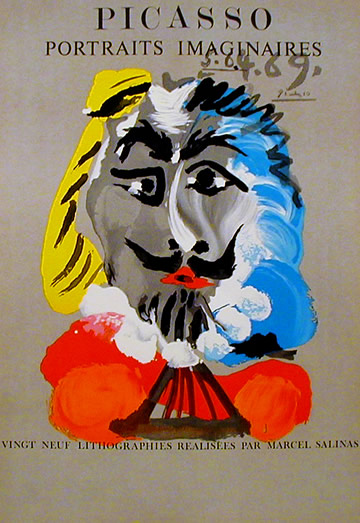
 In a recent article entitled, Lifestyles of the 2008 Presidential Candidates - How Our Potential Presidents Live in Real Life, AOL Money and Finance (June 3, 2008), Democratic Presidential Candidate Barack Obama reveals that one of his ''personal heroes' is famous Spanish Surrealist artist Pablo Picasso.
In a recent article entitled, Lifestyles of the 2008 Presidential Candidates - How Our Potential Presidents Live in Real Life, AOL Money and Finance (June 3, 2008), Democratic Presidential Candidate Barack Obama reveals that one of his ''personal heroes' is famous Spanish Surrealist artist Pablo Picasso.
 According to the Metropolitan
According to the Metropolitan  Museum of Art in New York, "The artistic genius of Pablo Picasso (1881–1973) has impacted the development of modern and contemporary art with unparalleled magnitude. His prolific output includes over 20,000 paintings, prints, drawings, sculptures, ceramics, theater sets and costumes that convey a myriad of intellectual, political, social, and amorous messages. His creative styles transcend realism and abstraction, Cubism, Neoclassicism, Surrealism, and Expressionism." See Pablo Picasso (1881–1973) at: http://www.metmuseum.org/TOAH/HD/pica/hd_pica.htm .
Museum of Art in New York, "The artistic genius of Pablo Picasso (1881–1973) has impacted the development of modern and contemporary art with unparalleled magnitude. His prolific output includes over 20,000 paintings, prints, drawings, sculptures, ceramics, theater sets and costumes that convey a myriad of intellectual, political, social, and amorous messages. His creative styles transcend realism and abstraction, Cubism, Neoclassicism, Surrealism, and Expressionism." See Pablo Picasso (1881–1973) at: http://www.metmuseum.org/TOAH/HD/pica/hd_pica.htm .Similarly, Encyclopedia Britannica reflects that,
 ... Life and career » Surrealism
... Life and career » Surrealismw
 riters. Inherent in Picasso’s work since the Demoiselles were many elements that the official circle advocated. The creation of monsters, for instance, could certainly be perceived in the disturbing juxtapositions and broken contours of the human figure in Cubist works; Breton specifically pointed to the strange Woman in a Chemise (1913).
riters. Inherent in Picasso’s work since the Demoiselles were many elements that the official circle advocated. The creation of monsters, for instance, could certainly be perceived in the disturbing juxtapositions and broken contours of the human figure in Cubist works; Breton specifically pointed to the strange Woman in a Chemise (1913).("In 1931, Universal Studios released the movie 'Frankenstein,' in which the monster as most of us recognise him today made his first appearance. The 1934 drawing appears to contain an inverted double portrait of Frankenstein's monster derived from this movie...
Picasso, who was often described as a monster, loved the cinema and probably saw the 1931 'Frankenstein' soon after its release in France. It appears clear from the drawing that he went on to identify a number of symbolic associations between himself and the monster and identified other symbolic associations between the monster and Hitler's Aryan Superman. Frankenstein's monster, like Oedipus and Picasso, were all in a sense responsible for the destruction of their fathers*. All three also Picasso symbolically, Oedipus by self infliction and suffered a form of blindness; Frankenstein's monster because at first his eyes were too sensitive to light. All three also underwent a form of crucifixion; Picasso symbolically, Oedipus when he is exposed by his father, the monster when he is created as well as when he dies under the sign of a burning cross. Finally, all three also experienced a form of exile; Picasso at the turn of the century in Paris and again in the 1930's as a protest against Franco, Oedipus by his own edict and the monster by being violently ostracised from the day of his creation." See Mark Harris, The Picasso Conspiracy, Symbolism in the 1934 Drawing - Frankenstein, at: http://web.org.uk/picasso/toc.html http://web.org.uk/picasso/symbolism.html http://web.org.uk/picasso/frankenstein.html ).
[IS GLOBAL WARMING SUCH A MONSTER??]
Moreover, the idea of reading one thing for another, an idea implicit in Synthetic Cubism, seemed to coincide with the dreamlike imagery the Surrealists championed.
 What the Surrealist movement gave to Picasso were new subjects—especially erotic ones—as well as a reinforcement of disturbing elements already in his work...the
What the Surrealist movement gave to Picasso were new subjects—especially erotic ones—as well as a reinforcement of disturbing elements already in his work...the  effect of distortion on the emotions of the spectator can also be interpreted as fulfilling one of the psychological aims of Surrealism (drawings and paintings of the Crucifixion, 1930–35).
effect of distortion on the emotions of the spectator can also be interpreted as fulfilling one of the psychological aims of Surrealism (drawings and paintings of the Crucifixion, 1930–35).In the 1930s Picasso, like many of the Surrealist writers, often played with the idea of metamorphosis.

...After the war Picasso resumed exhibiting his work, which included painting and sculpture as well as work in lithography and ceramics. At the Autumn Salon of 1944 (“Salon de la Liberation”) Picasso’s canvases and sculpture of the preceding five years were received as a shock.
 This plus the announcement that Picasso had just joined the Communist Party led to demonstrations against his political views in the gallery itself...
This plus the announcement that Picasso had just joined the Communist Party led to demonstrations against his political views in the gallery itself...... Because Picasso’s art from the time of the Demoiselles was radical in nature, virtually no 20th-century artist could escape his influence. Moreover, while other masters such as Matisse or Braque tended to stay within the bounds of a style they had developed in their youth, Picasso continued to be an innovator into the last decade of his life."
See: Pablo Picasso, Surrealism, at Encyclopædia Britannica.com at: http://www.britannica.com/eb/article-59635/Pablo-Picasso ; and
http://www.britannica.com/EBchecked/topic/459275/Pablo-Picasso .








